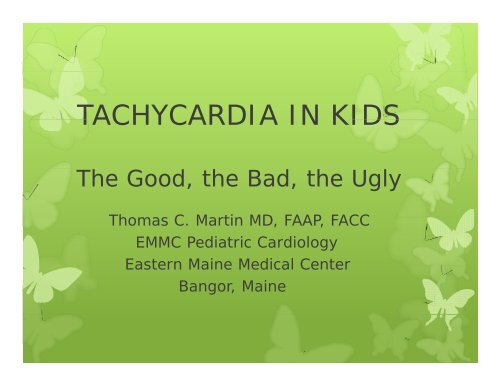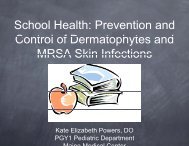TACHYCARDIA IN KIDS - Maine Chapter of the American Academy ...
TACHYCARDIA IN KIDS - Maine Chapter of the American Academy ...
TACHYCARDIA IN KIDS - Maine Chapter of the American Academy ...
You also want an ePaper? Increase the reach of your titles
YUMPU automatically turns print PDFs into web optimized ePapers that Google loves.
<strong>TACHYCARDIA</strong> <strong>IN</strong> <strong>KIDS</strong><br />
The Good, <strong>the</strong> Bad, <strong>the</strong> Ugly<br />
Thomas C. Martin MD, FAAP, FACC<br />
EMMC Pediatric Cardiology<br />
Eastern <strong>Maine</strong> Medical Center<br />
Bangor, <strong>Maine</strong>
DISCLAIMER<br />
Presentation at <strong>the</strong> <strong>Maine</strong> <strong>Chapter</strong>,<br />
<strong>American</strong> <strong>Academy</strong> <strong>of</strong> Pediatrics,<br />
Spring Educational Conference, Bar<br />
Harbor, <strong>Maine</strong> May 4, 2013.<br />
I have no financial relationships or<br />
conflicts in relation to <strong>the</strong> products<br />
or services described d in this<br />
presentation.
<strong>IN</strong>TRODUCTION<br />
Tachycardia in children may be a<br />
sign <strong>of</strong> clinical problems that range<br />
from trivial to life-threatening.<br />
As a primary care provider, it would<br />
be nice to know which fall in <strong>the</strong><br />
latter category.<br />
Hopefully, we can provide you with<br />
Hopefully, we can provide you with<br />
some useful hints and guidelines.
<strong>IN</strong>ITIAL APPROACH
THE GOOD<br />
Sinus tachycardia is <strong>the</strong> most<br />
frequent finding in children with<br />
rapid heart rates.<br />
Definition varies with age: 160-200<br />
bpm in infants, 140-180180 bpm in<br />
child, 100-150 bpm in young adults.<br />
For exercise stress testing, <strong>the</strong><br />
predicted maximum heart rate =<br />
220 – age (in years).
S<strong>IN</strong>US <strong>TACHYCARDIA</strong>
S<strong>IN</strong>US <strong>TACHYCARDIA</strong><br />
May be seen with myocarditis,<br />
Kawasaki disease, acute rheumatic<br />
fever or congestive heart failure but<br />
mostly not due to heart problem.<br />
Consider hypoxemia, hypoglycemia,<br />
shock, sepsis, anemia, pain, fever,<br />
anxiety, hyperthyroidism, y drug<br />
effect, electrolyte issues etc.<br />
Treat underlying cause ra<strong>the</strong>r than<br />
Treat underlying cause ra<strong>the</strong>r than<br />
treat <strong>the</strong> tachycardia itself.
POSTURAL <strong>TACHYCARDIA</strong><br />
SYNDROME (POTS)<br />
Common in teens and young adults.<br />
Autonomic neuropathy, baroreflex<br />
abnormalities, hypovolemia,<br />
sympa<strong>the</strong>tic hyperactivity, etc.<br />
Tilt table testing: Pulse increases<br />
30 bpm or over 120 bpm, flat to<br />
upright.<br />
Volume, fludrocortisone, midodrine,<br />
propranolol improve tilt table test.
<strong>TACHYCARDIA</strong>, NO SHOCK
THE BAD<br />
Tachycardia y in children causing<br />
clinical deterioration as <strong>the</strong> primary<br />
issue.<br />
Most <strong>of</strong>ten due to abnormal cardiac<br />
wiring causing electrical “short<br />
circuit”.<br />
The most frequent model for<br />
reentrant supraventricular<br />
tachycardia (SVT) is Wolff-Parkinson<br />
–White syndrome.
SUPRAVENTRICULAR<br />
<strong>TACHYCARDIA</strong>
WOLFF-PARK<strong>IN</strong>SON-<br />
WHITE ECG PATTERN
WHY WOLFF-PARK<strong>IN</strong>SON-<br />
WHITE ECG PATTERN?
WHY WOLFF-PARK<strong>IN</strong>SON-<br />
WHITE <strong>TACHYCARDIA</strong>?
SUPRAVENTRICULAR<br />
<strong>TACHYCARDIA</strong><br />
SVT has a regular, narrow QRS<br />
complex tachycardia on ECG.<br />
Heart rate over 220 bpm in infants,<br />
over 180 bpm in older children.<br />
Adenosine or DC cardioversion.<br />
No WPW: digoxin, beta-blocker.<br />
WPW: beta-blocker.<br />
If resistant: procainamide,<br />
p ,<br />
flecainide, sotalol or amiodarone.
SUPRAVENTRICULAR<br />
<strong>TACHYCARDIA</strong><br />
1 in 10,000000 kids. 1/3 with WPW.<br />
No heart disease in 90%.<br />
Narrow QRS complex tachycardia<br />
also includes atrial fibrillation and<br />
atrial flutter.<br />
Seen in normal newborns or in<br />
children with heart disease.<br />
Adenosine to diagnose.<br />
Digoxin, beta-blocker to treat.
ATRIAL FIBRILLATION
ATRIAL FLUTTER
THE UGLY<br />
Dangerous tachycardia that you<br />
hope not to see in your <strong>of</strong>fice.<br />
Wide QRS complex rhythms <strong>of</strong>ten<br />
with hemodynamic collapse.<br />
This group includes ventricular<br />
tachycardia, ventricular fibrillation,<br />
torsades de pointes, and atrial<br />
fibrillation with WPW.
VENTRICULAR<br />
<strong>TACHYCARDIA</strong>
VENTRICULAR<br />
<strong>TACHYCARDIA</strong><br />
WHO GETS IT?: Patients with<br />
myocarditis or cardiomyopathy,<br />
y,<br />
after cardiac surgery with<br />
ventriculotomy (e.g. tetralogy <strong>of</strong><br />
Fallot), ingestions (e.g. tricyclic<br />
antidepressants), occasionally in<br />
setting <strong>of</strong> normal heart.
VENTRICULAR<br />
FIBRILLATION
VENTRICULAR<br />
FIBRILLATION<br />
WHO GETS IT?: Patients with<br />
myocarditis or cardiomyopathy,<br />
y,<br />
after cardiac surgery with<br />
ventriculotomy (e.g. tetralogy <strong>of</strong><br />
Fallot), ingestions (e.g. tricyclic<br />
antidepressants), occasionally in<br />
setting <strong>of</strong> normal heart.
TORSADES DE PO<strong>IN</strong>TES
TORSADES DE PO<strong>IN</strong>TES<br />
WHO GETS IT?: Patients with long<br />
QT syndrome, ei<strong>the</strong>r congenital<br />
from a genetic defect in ion<br />
transport, or acquired secondary to<br />
certain medications. Sudden death,<br />
syncope or deafness in family.
ATRIAL FIBRILLATION<br />
WITH WPW
ATRIAL FIBRILLATION<br />
WITH WPW<br />
WHO GETS IT?: Patients with Wolff-<br />
Parkinson-White pattern with bypass<br />
tracts t conducting very well in<br />
antegrade direction.<br />
WPW has 3% rate <strong>of</strong> sudden death,<br />
atrial fibrillation more common than<br />
general population.<br />
Avoid digoxin, verapamil.
ATRIAL FIBRILLATION AND<br />
WPW
THE UGLY<br />
These rhythms are ugly with wide<br />
QRS complex, <strong>of</strong>ten irregular.<br />
Cardiopulmonary d o a y resuscitation first.<br />
Ventricular tachycardia, ventricular<br />
fibrillation, atrial fibrillation with<br />
WPW: defibrillation, epinephrine,<br />
amiodarone.<br />
Torsades de pointes: beta-blocker<br />
for congenital long QT; tranvenous<br />
pacing, IV magnesium for acquired.
PALS:
SUMMARY<br />
Tachycardia is good, a benign<br />
adaptive finding in most cases in<br />
most children.<br />
Tachycardia with persistent high<br />
pulse rates and reduced perfusion<br />
require an urgent approach.<br />
ECG monitoring will reveal <strong>the</strong> bad<br />
and <strong>the</strong> ugly rhythms requiring<br />
emergent intervention.
REFERENCES<br />
Mazor S, Mazor R. Approach to <strong>the</strong><br />
child with tachycardia. May 4, 2012.<br />
www.uptodate.com, accessed Apr<br />
12, 2013.<br />
Freeman R, Kaufman H. Postural<br />
tachycardia syndrome. Feb 25,<br />
2013. www.uptodate.com, t accessed<br />
Apr 12, 2013.





